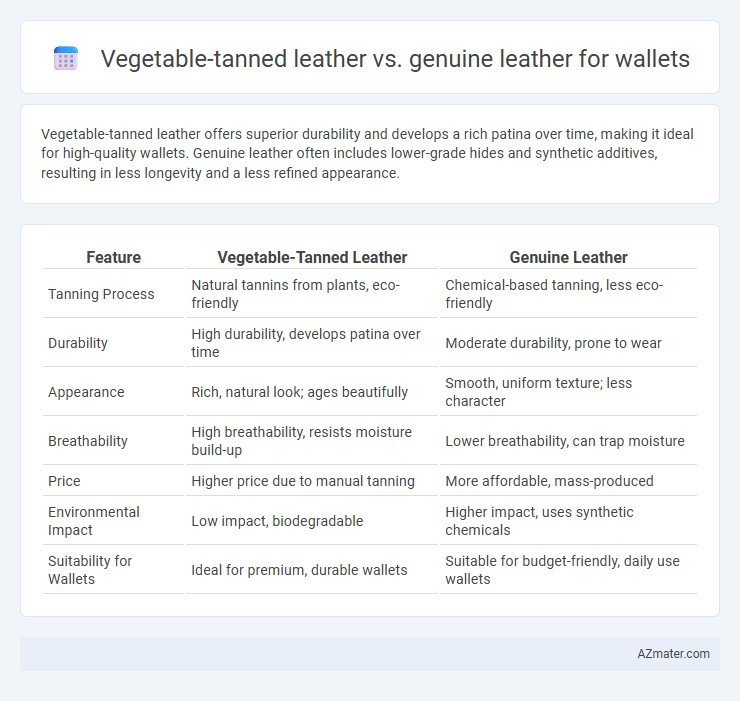Vegetable-tanned leather offers superior durability and develops a rich patina over time, making it ideal for high-quality wallets. Genuine leather often includes lower-grade hides and synthetic additives, resulting in less longevity and a less refined appearance.
Table of Comparison
| Feature | Vegetable-Tanned Leather | Genuine Leather |
|---|---|---|
| Tanning Process | Natural tannins from plants, eco-friendly | Chemical-based tanning, less eco-friendly |
| Durability | High durability, develops patina over time | Moderate durability, prone to wear |
| Appearance | Rich, natural look; ages beautifully | Smooth, uniform texture; less character |
| Breathability | High breathability, resists moisture build-up | Lower breathability, can trap moisture |
| Price | Higher price due to manual tanning | More affordable, mass-produced |
| Environmental Impact | Low impact, biodegradable | Higher impact, uses synthetic chemicals |
| Suitability for Wallets | Ideal for premium, durable wallets | Suitable for budget-friendly, daily use wallets |
Introduction to Leather Types for Wallets
Vegetable-tanned leather is crafted using natural tannins from plant materials, offering durability, a rich patina, and eco-friendly benefits. Genuine leather, often made from lower-grade hides and treated with chemicals, provides affordability but lacks the longevity and unique aging characteristics of vegetable-tanned leather. Understanding these differences helps in selecting a wallet that balances quality, appearance, and sustainability.
What is Vegetable-Tanned Leather?
Vegetable-tanned leather is a natural, eco-friendly material tanned using tannins extracted from tree bark, leaves, and other plant sources, resulting in a durable and firm texture ideal for wallets. This tanning process enhances the leather's ability to develop a rich patina over time, distinguishing it from genuine leather, which often relies on synthetic or chrome tanning methods. Wallets made from vegetable-tanned leather offer increased longevity, breathability, and unique aging characteristics compared to conventional genuine leather options.
What is Genuine Leather?
Genuine leather refers to leather made from the lower layers of animal hide, typically thinner and less durable than top-grain or full-grain leather. It undergoes extensive processing and chemical treatments, which can reduce its natural breathability and strength compared to vegetable-tanned leather. Wallets made from genuine leather often offer affordability but may lack the longevity and natural patina development characteristic of vegetable-tanned leather.
Key Differences: Vegetable-Tanned vs Genuine Leather
Vegetable-tanned leather is crafted using natural tannins from plant materials, resulting in a durable, biodegradable, and aesthetically rich material that develops a unique patina over time. Genuine leather, often made from lower-quality hides and processed with chemical tanning methods, tends to be less durable and has a uniform appearance without significant aging characteristics. The key differences lie in tanning techniques, environmental impact, durability, and the aging process, making vegetable-tanned leather a preferred choice for premium wallets.
Durability and Longevity Comparison
Vegetable-tanned leather offers superior durability and develops a rich patina over time, enhancing the wallet's aesthetic and resilience. Genuine leather, often chrome-tanned, tends to be less durable and may wear out faster under daily use. The natural tanning process of vegetable-tanned leather results in a wallet that ages gracefully and lasts significantly longer than most genuine leather counterparts.
Environmental Impact and Sustainability
Vegetable-tanned leather for wallets utilizes natural tannins from tree bark and plants, reducing harmful chemical runoff and promoting biodegradability, which enhances its environmental sustainability compared to genuine leather. Genuine leather often involves chrome tanning, a process that releases toxic waste and contributes to pollution, negatively impacting ecosystems. Choosing vegetable-tanned leather supports eco-friendly leather production and decreases the carbon footprint associated with traditional leather tanning methods.
Wallet Aesthetics: Appearance and Aging
Vegetable-tanned leather wallets develop a rich patina over time, enhancing their aesthetics with unique color variations and a natural, supple texture that ages gracefully. Genuine leather wallets typically exhibit a more uniform appearance but may show quicker signs of wear and fading due to their mix of leather types and finishes. The aging process in vegetable-tanned leather adds character and depth, making each wallet visually distinct compared to the often more synthetic look of genuine leather as it wears.
Cost Differences: Vegetable-Tanned vs Genuine Leather Wallets
Vegetable-tanned leather wallets generally cost more than genuine leather wallets due to the time-intensive tanning process using natural tannins from tree bark and plants, which enhances durability and develops a unique patina over time. Genuine leather wallets, often made from lower-grade hides and treated with synthetic chemicals, are more affordable but may lack the long-lasting quality and character found in vegetable-tanned options. Consumers prioritizing budget may prefer genuine leather for cost savings, while those seeking premium quality and eco-friendly production often invest in higher-priced vegetable-tanned leather wallets.
Care and Maintenance Tips
Vegetable-tanned leather wallets require gentle cleaning with a damp cloth and periodic application of natural oils to maintain suppleness and prevent dryness, whereas genuine leather wallets often need a specialized leather conditioner to avoid cracking and stiffness. Avoid exposure to excessive moisture and direct sunlight for both types to prolong lifespan and preserve color. Storing wallets in a cool, dry place and using dust bags can minimize wear and maintain their texture over time.
Which Leather is Best for Your Wallet?
Vegetable-tanned leather offers durability and develops a rich patina over time, making it an excellent choice for wallets that age gracefully and gain character. Genuine leather, often corrected or split, provides affordability and wide availability but may lack the natural texture and longevity found in vegetable-tanned options. For a wallet that combines quality, aesthetic appeal, and long-term resilience, vegetable-tanned leather is generally considered the superior choice.

Infographic: Vegetable-tanned leather vs Genuine leather for Wallet
 azmater.com
azmater.com